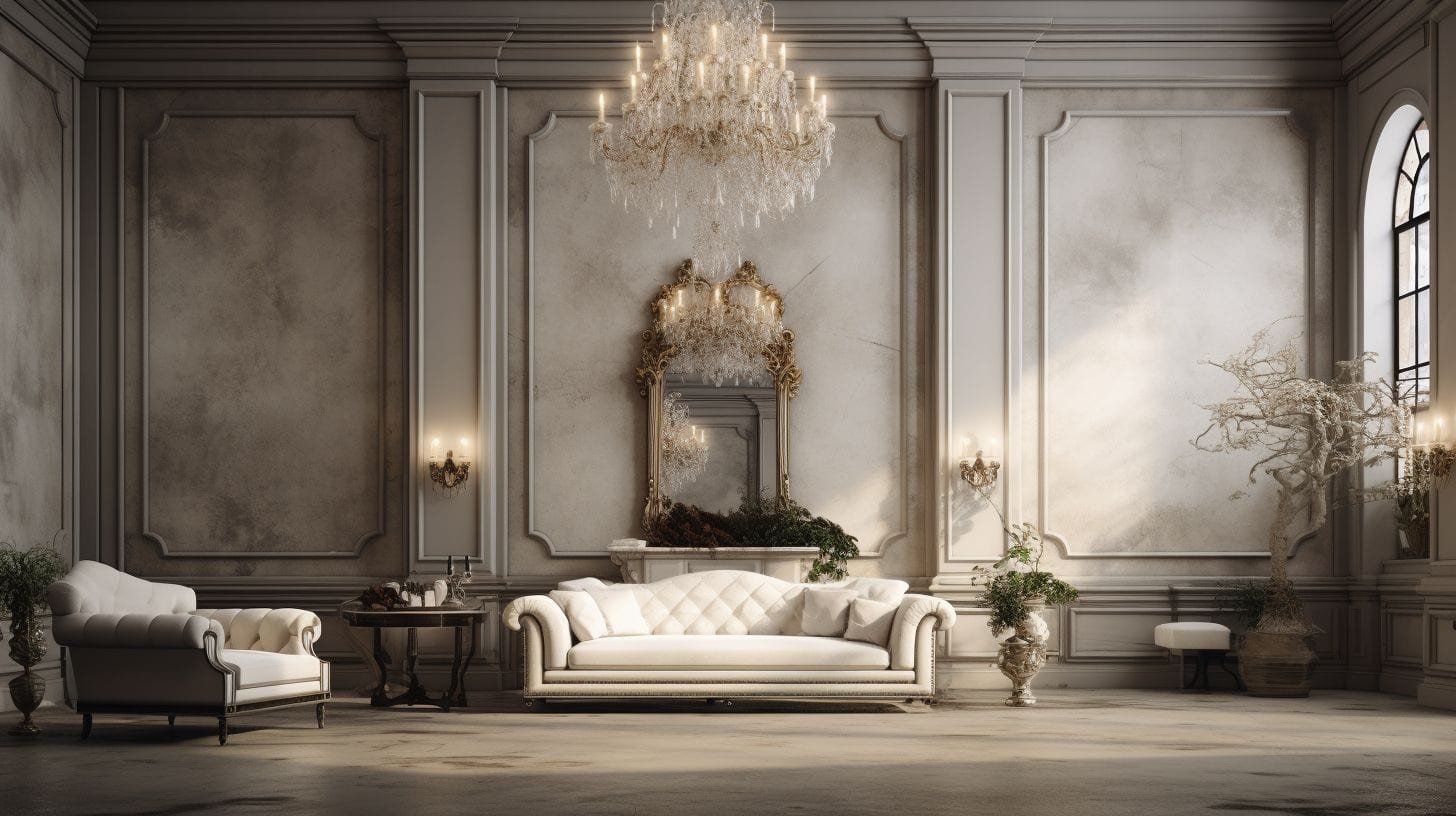Venetian plaster, a centuries-old decorative finish, has graced the walls of Italy’s most opulent palaces and villas since the Renaissance. Known for its luxurious, marble-like appearance, Venetian plaster remains a popular choice for adding elegance and sophistication to interiors. This exquisite finish, made from lime, marble dust, and water, offers versatility in texture and colour, making it suitable for a wide range of applications.
Classic Venetian plaster, rooted in ancient techniques, represents the pinnacle of artisanal craftsmanship. Its traditional composition and application methods have stood the test of time, providing a durable and stunning finish. This article delves into the composition of classic Venetian plaster, explores its traditional application methods, and highlights its common uses and finishes, showcasing its enduring appeal.

Composition of Classic Venetian Plaster
Ingredients: The Essence of Classic Venetian Plaster
Classic Venetian plaster boasts a simple yet refined composition that contributes to its unique aesthetic and durability. The primary ingredients include:
- Lime: Traditionally sourced from limestone, lime acts as the base and binding agent for the plaster. It undergoes a transformation through a process called slaking, where limestone is heated to produce quicklime, which is then mixed with water to create hydrated lime.
- Marble Dust: Finely ground marble dust is blended into the lime to enhance the plaster’s texture and appearance. The marble dust imparts a subtle sparkle and helps achieve the characteristic smooth, polished finish.
- Water: Water is essential for mixing and applying the plaster, ensuring the right consistency and workability.
Natural vs. Synthetic Ingredients
While classic Venetian plaster traditionally relies on natural ingredients, modern variations may incorporate synthetic components for enhanced durability and ease of application. However, purists argue that the use of natural materials is crucial for achieving the authentic look and feel of classic Venetian plaster.
Benefits of Using Traditional Materials
- Authenticity: Using traditional materials preserves the historical integrity of Venetian plaster, maintaining its timeless appeal.
- Breathability: Lime-based plaster is highly breathable, allowing moisture to evaporate and preventing issues like mould and mildew.
- Eco-Friendly: Natural ingredients like lime and marble dust are environmentally friendly, making classic Venetian plaster a sustainable choice.
- Durability: The natural composition of Venetian plaster provides exceptional durability, ensuring a long-lasting finish that can withstand the test of time.
Traditional Application Methods
Surface Preparation
Cleaning the Surface
Proper surface preparation is vital for the successful application of Venetian plaster. Start by cleaning the surface thoroughly to remove any dirt, grease, or existing coatings. This ensures optimal adhesion of the plaster and prevents imperfections.
Patching and Repairing
Inspect the surface for any cracks, holes, or irregularities. Patch and repair these areas using appropriate fillers to create a smooth and even base. This step is crucial for achieving the desired finish and preventing future damage.
Priming for Venetian Plaster
Once the surface is clean and repaired, apply a suitable primer. Priming enhances the plaster’s adhesion, ensuring a durable and long-lasting finish. Choose a primer compatible with lime-based plasters for best results.
Base Coat Application
Choosing the Right Base Coat
Select a base coat that complements the type of Venetian plaster you are using. The base coat provides a foundation for the subsequent layers, contributing to the overall look and feel of the finish.
Techniques for a Smooth Base Coat
Apply the base coat using a trowel, ensuring an even and consistent layer. Use broad, sweeping motions to cover the entire surface, maintaining a smooth and uniform texture.
Drying Time Considerations
Allow the base coat to dry completely before proceeding to the next layer. Depending on the environmental conditions, this may take several hours to a day. Proper drying is essential to avoid issues like cracking or bubbling.
Layering Process
Applying the First Layer: Techniques and Tools
Using a stainless steel trowel, apply the first layer of Venetian plaster in thin, even coats. Work in small sections, using smooth, overlapping strokes to create a uniform base. Allow this layer to dry partially before applying the next.
Second Layer Application: Achieving Smoothness
Apply the second layer using similar techniques, but with a focus on achieving a smoother finish. Use gentle pressure and consistent strokes to minimize texture and enhance the plaster’s polished appearance.
Third Layer: Final Touches for Perfection
The third layer is where the craftsmanship truly shines. Apply a thin, final coat with meticulous attention to detail, ensuring a flawless, smooth surface. This layer will define the plaster’s final look and feel.
Burnishing Techniques
Timing and Tools for Burnishing
Burnishing is a critical step in achieving the high-gloss finish characteristic of classic Venetian plaster. Use a clean, stainless steel trowel or a specialized burnishing tool. Begin burnishing while the plaster is still slightly damp but firm to the touch.
Achieving a High-Gloss Finish
Apply firm, even pressure with the trowel, using smooth, overlapping strokes. The friction generates heat, which helps to polish the plaster and bring out its natural luster. Repeat the process until the desired shine is achieved.
Common Uses of Classic Venetian Plaster
Residential Applications
Living Rooms and Bedrooms
Classic Venetian plaster brings a touch of elegance and sophistication to living spaces. In living rooms, its smooth, polished finish creates a stunning focal point, while in bedrooms, it adds a serene and luxurious ambiance. The versatility in colours and textures allows homeowners to customise their interiors to match any design style, from classic to contemporary.
Bathrooms and Kitchens
The durability and moisture-resistant properties of classic Venetian plaster make it an excellent choice for bathrooms and kitchens. Its smooth, polished surface is not only aesthetically pleasing but also easy to clean and maintain. In bathrooms, it can withstand humidity without deteriorating, making it ideal for walls and even ceilings. In kitchens, its elegant finish enhances the overall aesthetic while providing a durable surface that stands up to daily wear and tear.
Commercial Applications
Hotels and Restaurants
In the hospitality industry, classic Venetian plaster exudes luxury and sophistication, making it a popular choice for hotels and restaurants. Its ability to create a unique and inviting atmosphere helps establishments stand out. Whether it’s a chic hotel lobby or a stylish restaurant interior, Venetian plaster provides a visually striking and enduring finish that impresses guests.
Office Spaces
In office environments, Venetian plaster adds a touch of elegance and professionalism. Its high-end appearance can enhance the ambiance of executive offices, conference rooms, and reception areas. Additionally, the durable and low-maintenance nature of Venetian plaster makes it a practical choice for high-traffic areas, ensuring that office spaces remain impressive and inviting.
Historical and Restoration Projects
Classic Venetian plaster is a preferred material for historical and restoration projects due to its traditional composition and application methods. When restoring historical buildings, using authentic materials like lime and marble dust ensures that the repairs blend seamlessly with the original structure.
The breathable nature of lime-based plaster is particularly beneficial in preserving the integrity of old buildings, preventing moisture build-up and damage. Venetian plaster’s timeless appeal and historical significance make it the perfect choice for maintaining the authenticity and beauty of heritage sites.
Finishes of Classic Venetian Plaster
High-Gloss Finish
Techniques for Achieving a Polished Look
Achieving a high-gloss finish with classic Venetian plaster involves careful burnishing and polishing. After applying the final layer of plaster, use a clean, stainless steel trowel to burnish the surface. Apply firm, consistent pressure and use smooth, overlapping strokes. This process generates heat through friction, which helps to polish the plaster and bring out its natural shine. For an even more pronounced gloss, you can apply a fine layer of soap or wax and continue burnishing.
Maintenance and Care
A high-gloss Venetian plaster finish is relatively easy to maintain. Regular dusting and occasional wiping with a damp cloth will keep the surface looking pristine. Avoid abrasive cleaners or tools, as they can scratch or dull the polished finish. Periodically, you may need to reapply a thin layer of wax to maintain the gloss and protect the surface from moisture and stains.
Matte Finish
Characteristics of Matte Venetian Plaster
Matte Venetian plaster offers a more subdued, elegant appearance compared to its high-gloss counterpart. It has a soft, velvety texture that diffuses light gently, creating a warm and inviting ambiance. This finish is ideal for spaces where a more understated, sophisticated look is desired.
Best Practices for Matte Application
To achieve a matte finish, apply the final layer of plaster with minimal burnishing. Instead of using a trowel to polish the surface, lightly smooth it out, allowing the natural texture to remain. This technique helps preserve the matte appearance while still providing the durability and aesthetic appeal of Venetian plaster.
Textured Finish
Creating Various Textures with Classic Venetian Plaster
Textured Venetian plaster adds depth and dimension to walls, making them visually interesting and unique. You can create various textures by adjusting the application techniques and using different tools, such as brushes, sponges, or speciality trowels.
Popular Texture Styles
Some popular textured finishes include:
- Marmorino: A traditional style that mimics the look of natural marble with subtle veining and colour variations.
- Stucco Veneziano: A more pronounced texture with noticeable ridges and valleys, giving walls a rustic, old-world charm.
- Scagliola: A highly decorative technique that imitates the appearance of inlaid stone or marble, often used for intricate designs and patterns.
Conclusion
Embracing the Timeless Art of Classic Venetian Plaster
Classic Venetian plaster, with its rich history and exquisite finish, remains a hallmark of elegance and craftsmanship. This article explored the essential components that make up this luxurious material: lime, marble dust, and water. These natural ingredients, when skillfully combined, create a plaster that is both durable and beautiful.
Mastering Traditional Application Methods
The traditional methods of applying Venetian plaster—meticulous surface preparation, precise layering, and expert burnishing—are critical to achieving its signature look. Each step, from cleaning and priming the surface to applying multiple layers and burnishing to a high gloss, requires attention to detail and an artisanal touch.
Versatility in Use
Classic Venetian plaster’s versatility makes it suitable for a variety of settings. Whether enhancing the walls of residential living rooms and bathrooms, adding sophistication to commercial spaces like hotels and offices, or restoring historical buildings, its application brings an unparalleled level of refinement and elegance.
Diverse Finishes for Unique Aesthetics
The finishes achievable with classic Venetian plaster range from the high-gloss sheen of polished plaster to the soft elegance of a matte finish and the intriguing textures of traditional styles like Marmorino and Stucco Veneziano. Each finish offers unique visual and tactile qualities, allowing for customised design solutions.
Preserving a Timeless Tradition
Preserving the traditional techniques of Venetian plaster application is essential for maintaining its authenticity and historical significance. These methods, passed down through generations, ensure that the beauty and durability of Venetian plaster continue to grace modern interiors while honouring its storied past.
Classic Venetian plaster is more than just a decorative finish; it is a testament to the enduring art of traditional craftsmanship. By embracing these time-honoured techniques, we can continue to appreciate and enjoy the timeless beauty of Venetian plaster in our contemporary spaces.
Experience Timeless Elegance with Our Classic Venetian Plaster Services in Sydney
At Venetian Plasterer, we bring the timeless elegance of classic Venetian plaster to life in Sydney. Our skilled artisans meticulously follow traditional application methods, combining lime and marble dust to create smooth, durable finishes that add sophistication to any space.
With a deep understanding of the composition and historical significance of Venetian plaster, we transform walls into stunning works of art, offering a range of common finishes that enhance both residential and commercial interiors.
Whether we are applying the plaster to feature walls, creating textured surfaces, or achieving high-gloss finishes, our dedication to quality and craftsmanship ensures that each project reflects the beauty and heritage of this ancient technique.
Related

